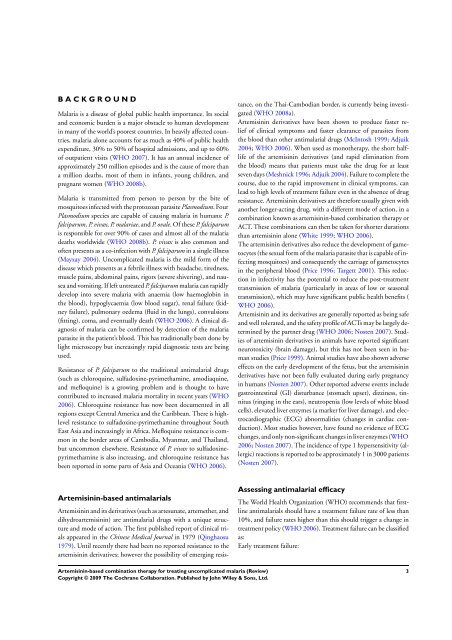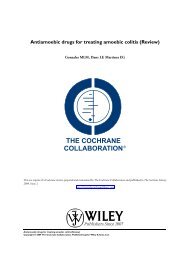Artemisinin-based combination therapy for ... - The Cochrane Library
Artemisinin-based combination therapy for ... - The Cochrane Library
Artemisinin-based combination therapy for ... - The Cochrane Library
You also want an ePaper? Increase the reach of your titles
YUMPU automatically turns print PDFs into web optimized ePapers that Google loves.
B A C K G R O U N D<br />
Malaria is a disease of global public health importance. Its social<br />
and economic burden is a major obstacle to human development<br />
in many of the world’s poorest countries. In heavily affected countries,<br />
malaria alone accounts <strong>for</strong> as much as 40% of public health<br />
expenditure, 30% to 50% of hospital admissions, and up to 60%<br />
of outpatient visits (WHO 2007). It has an annual incidence of<br />
approximately 250 million episodes and is the cause of more than<br />
a million deaths, most of them in infants, young children, and<br />
pregnant women (WHO 2008b).<br />
Malaria is transmitted from person to person by the bite of<br />
mosquitoes infected with the protozoan parasite Plasmodium. Four<br />
Plasmodium species are capable of causing malaria in humans: P.<br />
falciparum, P. vivax, P. malariae, and P. ovale. Of these P. falciparum<br />
is responsible <strong>for</strong> over 90% of cases and almost all of the malaria<br />
deaths worldwide (WHO 2008b). P. vivax is also common and<br />
often presents as a co-infection with P. falciparum in a single illness<br />
(Mayxay 2004). Uncomplicated malaria is the mild <strong>for</strong>m of the<br />
disease which presents as a febrile illness with headache, tiredness,<br />
muscle pains, abdominal pains, rigors (severe shivering), and nausea<br />
and vomiting. If left untreated P. falciparum malaria can rapidly<br />
develop into severe malaria with anaemia (low haemoglobin in<br />
the blood), hypoglycaemia (low blood sugar), renal failure (kidney<br />
failure), pulmonary oedema (fluid in the lungs), convulsions<br />
(fitting), coma, and eventually death (WHO 2006). A clinical diagnosis<br />
of malaria can be confirmed by detection of the malaria<br />
parasite in the patient’s blood. This has traditionally been done by<br />
light microscopy but increasingly rapid diagnostic tests are being<br />
used.<br />
Resistance of P. falciparum to the traditional antimalarial drugs<br />
(such as chloroquine, sulfadoxine-pyrimethamine, amodiaquine,<br />
and mefloquine) is a growing problem and is thought to have<br />
contributed to increased malaria mortality in recent years (WHO<br />
2006). Chloroquine resistance has now been documented in all<br />
regions except Central America and the Caribbean. <strong>The</strong>re is highlevel<br />
resistance to sulfadoxine-pyrimethamine throughout South<br />
East Asia and increasingly in Africa. Mefloquine resistance is common<br />
in the border areas of Cambodia, Myanmar, and Thailand,<br />
but uncommon elsewhere. Resistance of P. vivax to sulfadoxinepyrimethamine<br />
is also increasing, and chloroquine resistance has<br />
been reported in some parts of Asia and Oceania (WHO 2006).<br />
<strong>Artemisinin</strong>-<strong>based</strong> antimalarials<br />
<strong>Artemisinin</strong> and its derivatives (such as artesunate, artemether, and<br />
dihydroartemisinin) are antimalarial drugs with a unique structure<br />
and mode of action. <strong>The</strong> first published report of clinical trials<br />
appeared in the Chinese Medical Journal in 1979 (Qinghaosu<br />
1979). Until recently there had been no reported resistance to the<br />
artemisinin derivatives; however the possibility of emerging resis-<br />
<strong>Artemisinin</strong>-<strong>based</strong> <strong>combination</strong> <strong>therapy</strong> <strong>for</strong> treating uncomplicated malaria (Review)<br />
Copyright © 2009 <strong>The</strong> <strong>Cochrane</strong> Collaboration. Published by John Wiley & Sons, Ltd.<br />
tance, on the Thai-Cambodian border, is currently being investigated<br />
(WHO 2008a).<br />
<strong>Artemisinin</strong> derivatives have been shown to produce faster relief<br />
of clinical symptoms and faster clearance of parasites from<br />
the blood than other antimalarial drugs (McIntosh 1999; Adjuik<br />
2004; WHO 2006). When used as mono<strong>therapy</strong>, the short halflife<br />
of the artemisinin derivatives (and rapid elimination from<br />
the blood) means that patients must take the drug <strong>for</strong> at least<br />
seven days (Meshnick 1996; Adjuik 2004). Failure to complete the<br />
course, due to the rapid improvement in clinical symptoms, can<br />
lead to high levels of treatment failure even in the absence of drug<br />
resistance. <strong>Artemisinin</strong> derivatives are there<strong>for</strong>e usually given with<br />
another longer-acting drug, with a different mode of action, in a<br />
<strong>combination</strong> known as artemisinin-<strong>based</strong> <strong>combination</strong> <strong>therapy</strong> or<br />
ACT. <strong>The</strong>se <strong>combination</strong>s can then be taken <strong>for</strong> shorter durations<br />
than artemisinin alone (White 1999; WHO 2006).<br />
<strong>The</strong> artemisinin derivatives also reduce the development of gametocytes<br />
(the sexual <strong>for</strong>m of the malaria parasite that is capable of infecting<br />
mosquitoes) and consequently the carriage of gametocytes<br />
in the peripheral blood (Price 1996; Targett 2001). This reduction<br />
in infectivity has the potential to reduce the post-treatment<br />
transmission of malaria (particularly in areas of low or seasonal<br />
transmission), which may have significant public health benefits (<br />
WHO 2006).<br />
<strong>Artemisinin</strong> and its derivatives are generally reported as being safe<br />
and well tolerated, and the safety profile of ACTs may be largely determined<br />
by the partner drug (WHO 2006; Nosten 2007). Studies<br />
of artemisinin derivatives in animals have reported significant<br />
neurotoxicity (brain damage), but this has not been seen in human<br />
studies (Price 1999). Animal studies have also shown adverse<br />
effects on the early development of the fetus, but the artemisinin<br />
derivatives have not been fully evaluated during early pregnancy<br />
in humans (Nosten 2007). Other reported adverse events include<br />
gastrointestinal (GI) disturbance (stomach upset), dizziness, tinnitus<br />
(ringing in the ears), neutropenia (low levels of white blood<br />
cells), elevated liver enzymes (a marker <strong>for</strong> liver damage), and electrocardiographic<br />
(ECG) abnormalities (changes in cardiac conduction).<br />
Most studies however, have found no evidence of ECG<br />
changes, and only non-significant changes in liver enzymes (WHO<br />
2006; Nosten 2007). <strong>The</strong> incidence of type 1 hypersensitivity (allergic)<br />
reactions is reported to be approximately 1 in 3000 patients<br />
(Nosten 2007).<br />
Assessing antimalarial efficacy<br />
<strong>The</strong> World Health Organization (WHO) recommends that firstline<br />
antimalarials should have a treatment failure rate of less than<br />
10%, and failure rates higher than this should trigger a change in<br />
treatment policy (WHO 2006). Treatment failure can be classified<br />
as:<br />
Early treatment failure:<br />
3








